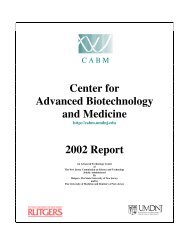Annual Report 2011 - Center for Advanced Biotechnology and ...
Annual Report 2011 - Center for Advanced Biotechnology and ...
Annual Report 2011 - Center for Advanced Biotechnology and ...
You also want an ePaper? Increase the reach of your titles
YUMPU automatically turns print PDFs into web optimized ePapers that Google loves.
atomic detail <strong>and</strong> have yielded numerous novel insights into polymerase structure-function<br />
relationships, detailed mechanisms of drug inhibition <strong>and</strong> resistance, <strong>and</strong> structure-based<br />
design of RT inhibitors. The team has solved a variety of crystal structures representing<br />
multiple functional states of HIV-1 RT. These structures include HIV-1 RT in complex with a<br />
double-str<strong>and</strong>ed DNA template-primer, HIV-1 RT complexes with RNA:DNA templateprimers,<br />
structures of RT with AZTMP-terminated primer representing pre-translocation <strong>and</strong><br />
post-translocation complexes, <strong>and</strong> ternary complexes of wild-type <strong>and</strong> drug-resistant RT with<br />
DNA, <strong>and</strong> AZT-triphosphate/tenofovir-diphosphate. We have also determined the structures<br />
of numerous non-nucleoside inhibitors with wild-type <strong>and</strong> drug resistant HIV-1 RT, <strong>and</strong> the<br />
structural in<strong>for</strong>mation was used in the design of two recently approved non-nucleoside drugs.<br />
Also, we have obtained structures of RT:RNase H inhibitor <strong>and</strong> RT:DNA:AZTppppA (an<br />
ATP-mediated AZT excision product) complexes (Tu et al., 2010).<br />
Drug development against <strong>and</strong> structural studies of a molecule as complex as HIV RT require<br />
immense <strong>and</strong> highly coordinated resources. The Arnold group has been <strong>for</strong>tunate to have<br />
successful long-term collaborations with the groups of Stephen Hughes (NIH NCI-Frederick),<br />
Roger Jones (Rutgers), Michael Parniak (U. of Pittsburgh), <strong>and</strong> Ronald Levy (Rutgers). The<br />
group also benefits from generous access to synchrotron X-radiation sources (CHESS, APS,<br />
<strong>and</strong> BNLS). Hughes <strong>and</strong> his coworkers have contributed expertise in protein engineering,<br />
production, <strong>and</strong> biochemistry at every stage of the RT project since its inception.<br />
Through collaboration with the late Dr. Paul Janssen we participated in a structure-based drug<br />
design ef<strong>for</strong>t that resulted in the discovery <strong>and</strong> development of non-nucleoside inhibitors<br />
(diarylpyrimidine, or DAPY analogs) with high potency against all known drug-resistant<br />
variants of HIV-1 RT. Crystallographic work from the Arnold <strong>and</strong> Hughes laboratories<br />
allowed precise visualization of how potential anti-HIV drug c<strong>and</strong>idates latch onto RT, their<br />
molecular target. Janssen <strong>and</strong> colleagues at the <strong>Center</strong> <strong>for</strong> Molecular Design successfully<br />
used this structural in<strong>for</strong>mation to guide the design <strong>and</strong> synthesis of new molecules with<br />
improved potency against wild-type <strong>and</strong> drug-resistant HIV-1 strains. Scientists at Tibotec, a<br />
subsidiary of Johnson & Johnson, tested the compounds <strong>for</strong> antiviral activity against wild-type<br />
<strong>and</strong> resistant HIV-1, <strong>and</strong> have led the clinical trials.<br />
The DAPY compounds are simple, inexpensive to make <strong>and</strong> have near ideal pharmacological<br />
properties. Etravirine (TMC125/Intelence) was approved <strong>for</strong> treatment of HIV infection by<br />
the FDA in 2008, <strong>and</strong> rilpivirine (TMC278) was approved as Edurant in May <strong>2011</strong>. In what<br />
may be unprecedented <strong>for</strong> a new best-in-class drug, Johnson & Johnson is permitting<br />
rilpivirine to be available in generic <strong>for</strong>m immediately in developing nations; this will make<br />
the drug available to millions of people. The prototypical DAPY compound,<br />
TMC120/dapivirine, is now being developed as a microbicide <strong>for</strong> blocking sexual<br />
transmission of HIV-1. A broader outcome of this study is a drug design concept <strong>for</strong><br />
overcoming drug resistance; the strategic flexibility that permits the DAPY compounds to<br />
“wiggle” <strong>and</strong> “jiggle” in a binding pocket to accommodate mutations apparently accounts <strong>for</strong><br />
their potency against a wide range of drug-resistant variants. Through a systematic protein<br />
engineering ef<strong>for</strong>t we obtained high-resolution crystals of HIV-1 RT <strong>and</strong> demonstrated that<br />
strategic flexibility of rilpivirine was responsible <strong>for</strong> its resilience against drug-resistant RT<br />
variants. Recent ef<strong>for</strong>ts include using the high-<br />
Dr. Ramaswamy<br />
S. Vijayan<br />
Postdoctoral Associate<br />
Dr. Angela<br />
McKoy<br />
Postdoctoral Fellow<br />
Dabyaben Patel<br />
Graduate Student<br />
Joseph Thomas<br />
Eck<br />
Graduate Fellow<br />
Arthur Clark<br />
Laboratory Researcher<br />
43



